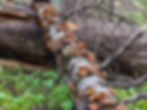Wood ear mushrooms are known for their use in Chinese dishes such as hot and sour soup or wood ear salad. While their flavor is mildly earthy, they bring a very interesting, snappy, and chewy texture to dishes they are used in. The American wood ear, Auricularia americana, is one of the more common species in North America and the only documented species here in Colorado. So, let's learn how to identify it, where to find it, and how to eat it!

Wood Ear Mushroom Description
Wood ear, Auricularia americana, also sometimes called tree ear, jelly ear, and jelly tree ear, are small, saprotrophic mushrooms that grow from the decaying wood of coniferous trees. They are usually tan or brown but can sometimes be light in color. They emerge singly or in small clusters, often from cracks or gaps in the bark of the dead conifers.

The mushrooms are generally ear-shaped but can be fan-like or somewhat amorphous. The top side of the mushroom is slightly textured or matte, while the underside is shiny. They have no stem but attach to the wood with a tougher, rubbery section. Their spores are white.

Range & Habitats
This species of wood ear mushroom is widely distributed in North America wherever coniferous trees can be found and has also been documented in parts of Asia. Since these can fruit from any dead coniferous wood, they can be found in many habitats. In Colorado, wood ear mushrooms prefer the wood of fir trees, Abies species. I most often find them on recently dead subalpine fir, Abies lasiocarpa. Look for logs that still have bark but are starting to decay. Other species of Auricularia grow from the wood of deciduous trees, such as A. angiospermarum and A. fuscosuccinea.

Potential Look-alikes
The information in the description above should be enough to identify wood ears properly. However, look-alike information is regularly requested, so here are some possible species that could be confused with wood ears. This list is not comprehensive and may not be relevant to your region. Remember only to eat wild foods once you're 100% confident in your identification and comfortable with trying something new.
Amber jelly roll, Exidia recisa. It grows from hardwoods and is less ear-shaped. In Colorado, they tend to grow from bur oak, Quercus macrocarpa, and Gambel oak, Q. gambelii. Amber jelly roll fungi are also edible.
Other jelly fungi in Tremella or related genera. Most, if not all, jelly fungi are safe.
Brown cup fungi such as Gyromitra perlata or Peziza species. These grow terrestrially and are not jelly-textured. Edibility is variable depending on the species.

Join The Forage Colorado Newsletter!
Sign up for our email newsletter to get seasonal foraging tips, wild food classes,
early access to foraging events, and more!
Edibility & Harvesting
Wood ear mushrooms are almost tasteless, with just a mild earthy flavor. They are used more for their texture, which is a bit crunchy and chewy. They are used in many Asian dishes, so look to those for inspiration. In Japan, wood ears are known as kikurage (キクラゲ) and are used in ramen and salads. In China, wood ear mushrooms (木耳; pinyin: mù'ěr) are used in salads, soups, stir-fries, and various other dishes.
Wood ears are one of the few mushrooms that can be found in the cold winter months. They will naturally dehydrate on logs and stumps and can be rehydrated by melting snow during warm spells. They can be harvested in either state during any season. During the warmer months, look for mushrooms that are firm. Wood ears that have started to decay will be soft and droopy. Leave these behind. To harvest, pinch or gently slice them away from the wood. For naturally dehydrated mushrooms, simply break them off the log. Remove the tough base and any residual wood or bark before cooking or storing them. Wood ear mushrooms dehydrate well and rehydrate back to an almost fresh state. They can be rehydrated with flavored liquids and readily absorb those flavors, providing interesting infusion opportunities. Candied wood ears infused with a wild liqueur?

Foraging Calendar
To learn more about the best seasons to harvest this species and many other wild foods, check out my Foraging Calendar & Wild Food Database! You can try the demo version to learn more, and join my Patreon to gain full access to the Foraging Calendar and other exclusive perks! Joining is the best way to support all the work I put into my content and website to help you learn about foraging! Thank you for checking it out!

